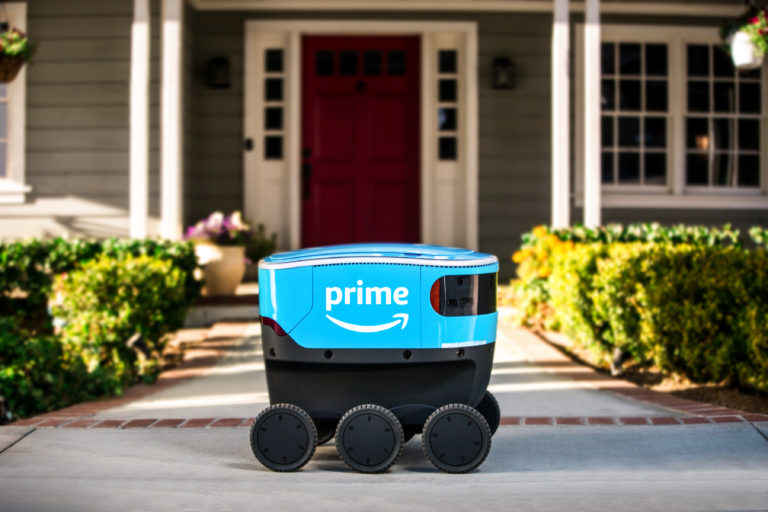Earlier this year, six delivery robots of the Amazon Scout delivery system were launched in a pilot program in Snohomish County, Washington. These box-shaped robots, which resemble six-wheeled ice boxes, carried meals, groceries and packages to homes and offices in that area north of Seattle. These robots join a small but growing number of robots, who are slowly moving on the sidewalks of London, Beijing and other cities and communities around the world. As they move, they face many pedestrian legs, curious dogs and cracked sidewalks, which raises an important question: why do companies invest in delivery robots from the original?
These services are gaining momentum as a growing number of urban dwellers are now relying on delivery services to get almost all their orders, instantly or on time. Between 2016 and 2017, online retail sales in the United States increased by 16% . Meal delivery companies are becoming increasingly popular, and online grocery sales are increasing. In the final phase of all these deliveries, called the last mile, parcels are usually carried by people riding bicycles, motorized scooters, or large delivery trucks. All of these vehicles crowd in already crowded urban streets. “deliver in all densely populated urban centers continue to increase, and if city and state leaders don’t start thinking about innovations like delivery ,” says Paul McKee, director of research and communications at the Mobility Lab, a transport policy research center in Arlington, Virginia. With robots, we can expect worse traffic jams as we all try to reach our destinations. “
A study by the Mobility Lab and George Mason University found that 73% of Arlington freight vehicles were parked outside authorized parking spaces, often blocking bicycle lanes and pedestrian crossings, and blocking access to fire hydrants. So, by moving the last phase of these deliver from the road to the sidewalk, cities can reduce traffic congestion and completely eliminate the problem of cargo vehicles parked outside parking spaces, according to Mackey.
But the purpose of entities, such as Amazon, to develop this delivery technology is not simply to eliminate traffic congestion. Self-driving vehicles and sidewalk robots can reduce delivery costs in the last mile of cities by up to 40%, according to a 2018 report by McKinsey & Company, a consultancy in New York. Manufacturing a single-delivery robot costs thousands of dollars, most of which now require human supervision and maintenance, but in the long run, companies that prove themselves to be self-driving delivery vehicles in the next few years could end up saving billions of dollars, the report said.
To gain public confidence, these machines must demonstrate that they can safely share pedestrian spaces with humans, without hindering or harassing them. Some US cities have streets and sidewalks that are often fairly empty and may not see any pedestrians passing for long hours. These streets and sidewalks can accommodate robots, says Renia Erinfoicht , head of community and regional planning at the University of New Mexico in Albuquerque and co-author of Sidewalks: Conflict and Negotiation in Public Space. But as the sidewalk becomes more crowded, even robots that are fast-paced walking will face some challenges, and these challenges will get worse in narrow-sidewalk American cities. “It is really hard to move through crowded sidewalks, not to hit people, and to do so smoothly,” says Erinfoicht. “Until delivery robots are so skilled, if they can, they will hinder people.”
The routine of sidewalk robots may also face some obstacles, including curious bystanders blocking their way, and thieves looking to steal packages as they deliver. This latter problem can be solved by using remote-controlled parcel closing mechanisms. But there are many examples of other obstacles, including a video released last year showing a robot delivering temporary immobility after children covered his cameras and sensors with snow. There is also the social experience of the Canadian robot hitchBOT, in which this simple human-like robot traveled through Canada and Europe, before he ended up beheaded in Philadelphia at the beginning of his American tour. “I really think the biggest problem will be either joking, or outright evil behavior,” says Mary Cummings , director of the Human and Self-Control Laboratory at Duke University.
But Starship Technologies, based in San Francisco and Estonia, is more optimistic. Hundreds of the company’s robots have already carried out 25,000 deliveries, traveling in local neighborhoods using machine learning software, sensors, and digital maps. “The majority of people who share pavements with his company’s robots hardly notice them, and when they do, it’s often positive,” says Ryan Tuhe, senior vice president of business development. “After our robots have been moving in an area for a while, people are used to it. Robots have become a part of society, and the population is careful for their safety. “These robots operate almost entirely independently in the areas identified on maps, but are subject to remote monitoring by human operators to intervene when needed. However, even StarShip Technologies has admitted that some people sometimes kick their $ 5,500 robots as they pass.
Other challenges include mastering software design that helps delivery robots avoid fixed and moving objects, and dealing with city officials who want to protect public spaces. For example, San Francisco – where some startups like DoorDash and Postmates are located – imposed a sudden ban in 2017 on self-propelled sidewalk robots, and companies wishing to acquire Permits to work only very slowly. Other American societies have established regulations on where these robots can go and how they should behave.
Given these obstacles, sidewalk robots may not dominate in the future. That’s why Nuro, a startup founded by two former employees of Google, has developed a driverless R1 that runs on the streets rather than on sidewalks. The vehicle joins the company’s current fleet of Toyota Prius self-driving cars, which have already completed nearly 1,000 grocery deliveries in Scottsdale, Arizona since mid-December 2018.Drones face their own challenges , but they can provide more widespread services in rural areas and suburbs that are not well maintained.
Ultimately, the best solution to this overflow of delivery vehicles may lie outside of technology.The McKinsey & Company 2016 report noted that old bikes are still the best cost option in the final phase of many deliveries.”If robots do not get much cheaper, cyclists may become the best means of instant delivery in urban areas,” the company’s analysts wrote.




